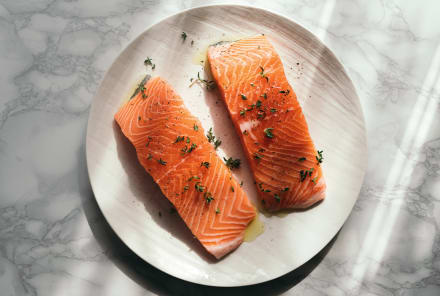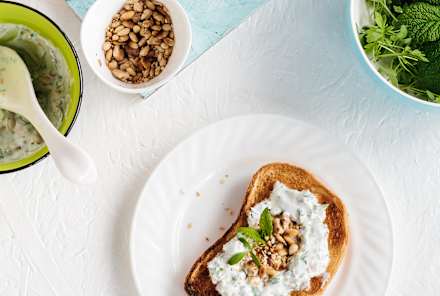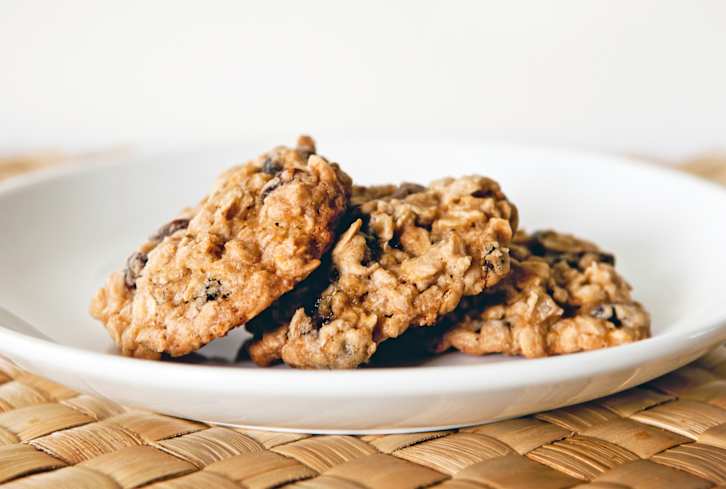Advertisement
Everything You Need To Know About Histamine Intolerance & Low-Histamine Diets


Histamine intolerance develops when your blood levels of histamine, one of the main chemicals involved in allergic reactions, get too high. If you have a histamine intolerance, you can get your symptoms under control by following a short-term low-histamine diet while you work to fix the root cause of the problem.
What causes histamine intolerance?
To understand histamine intolerance, it's helpful to have a background on histamine first. Histamine is a chemical compound that's involved in immune function. When you're exposed to an allergen or harmful substance, your body releases histamine to fight off the potential harm.
Histamine has other roles too, like helping with digestion, wound healing, and nerve signaling in the brain1. Because of this, it's important to have some, but problems arise when you're exposed to too much or develop a reaction to normal amounts.
A histamine intolerance develops when the amount of histamine that accumulates in your body is greater than the amount of histamine your body can eliminate. Having a histamine intolerance doesn't mean that you're allergic or sensitive to histamine; it simply means that there's too much in your body.
Some things that can cause a histamine intolerance are:
- Allergies
- Bacterial overgrowth or imbalanced gut flora
- Mastocytosis: a condition characterized by the presence of too many mast cells
- Gastrointestinal bleeding
- Gastrointestinal disorders like Crohn's disease
- Chronic use of NSAIDs or histamine blockers
- Celiac disease
But while there are several possible underlying root causes, the most common cause of histamine intolerance1 is a problem with the way an enzyme called diamine oxidase, or DAO, works in your body.
Normally, histamine travels to the gut, where DAO breaks it down and prevents it from entering the bloodstream. However, if you don't have adequate levels of DAO, histamine passes through the small intestine, where it gets into your blood. Over time, this can lead to high levels of histamine that cause the uncomfortable symptoms associated with histamine intolerance.
So, what causes low DAO? In some cases, your genes may play a role, but things like excessive alcohol consumption, overuse of NSAIDs, leaky gut, and small intestinal bacterial overgrowth (or SIBO) can also reduce your levels.
Symptoms of histamine intolerance.
Because histamine is one of the main chemicals involved in allergic reactions, the symptoms of histamine intolerance closely mimic an allergy (even though it isn't a true allergy).
Some of the most common complaints are:
- Frequent headaches or migraines
- Anxiety
- Nausea or vomiting
- Stomach cramps, bloating, and diarrhea
- Nasal congestion or difficulty breathing
- Frequent sneezing
- Irregular menstrual cycles in women
- Dizziness or vertigo
- Difficulty regulating body temperature
- Asthma
It's currently estimated that about 1% of the population suffers from histamine intolerance, although some researchers believe that number is highly underestimated1. That's because many physicians overlook histamine intolerance, and it can be difficult to diagnose.
How to find out if you have histamine intolerance.
Some researchers have recommended standard allergy testing or skin prick tests to diagnose histamine intolerance, but since it's not a true allergy and histamine can take a while to accumulate in the body, these tests are not the ideal choice.
There's no direct testing for histamine intolerance, but your doctor can use a combination of tests to determine the likelihood that you have it. Some of the most useful options are:
- Genetic testing for variations in DAO, HNMT, and other DAO-affecting genes
- Serum DAO (the amount of DAO in your blood)
While these tests may help indirectly diagnose histamine intolerance, Nour Zibdeh, M.S., RDN, points out that the fastest and easiest way for you and your doctor to confirm (or rule out) a histamine intolerance is to follow a low-histamine diet.
The low-histamine diet.
The biggest difference between a histamine intolerance and an allergy is how much it takes to trigger a reaction. In a true allergy, even a small amount of the allergen can cause a severe reaction. However, with histamine intolerance, symptoms generally develop only after a large enough amount of histamine has accumulated2. That's why a low-histamine diet is so effective.
Your body naturally produces histamine, but the chemical compound also comes from the food you eat. The goal of a low-histamine diet is to drop your body's histamine levels. This is done through a combination of avoiding foods that are high in histamine (and foods that trigger your body to release histamine) and using proper food preparation and storage techniques.
Although a low-histamine diet can feel overwhelming at first, it's highly effective and worth the effort if you have histamine intolerance. In one study, participants with chronic hives were put on a low-histamine diet. After four weeks, all participants saw significant reductions in blood histamine levels3 and body distribution of hives.
In addition to directly lowering the amount of histamine in your body, other research shows that a low-histamine diet can also increase the amount of DAO4 that the body makes, helping to boost its ability to break down excess histamine.
Foods that are high in histamines.
Some foods that are naturally high in histamine include:
- Fermented foods (kimchi, sauerkraut, kombucha, kefir, pickles, and yogurt)
- Aged cheeses
- Sour cream
- Avocado
- Dried fruit (raisins, prunes, dates, figs)
- Certain fish (sardines, mackerel, herring tuna)
- Soybeans
- Chickpeas
- Lentils
- Moldy foods or cheeses (like blue cheese)
- Any foods or supplements that contain yeast (sourdough bread, nutritional yeast)
- Vinegar and any condiments that contain vinegar (ketchup, mustard, mayonnaise, and salad dressing)
- Bone broth
- Processed or cured meats (bacon, salami, and pepperoni)
- Canned foods
- Chili powder, cinnamon, and cloves
Foods that trigger the release of histamines
Some foods that aren't naturally high in histamine but can trigger your immune system to release a high amount of histamine are:
- Alcohol
- Bananas
- Chocolate
- Citrus fruits (lemon, lime, grapefruit, orange, and kiwi)
- Egg whites
- Milk
- Nuts
- Papaya
- Pineapple
- Pork
- Shellfish
- Spinach
- Strawberries
- Tomatoes
- Wheat germ
- Artificial dyes
Things that block DAO:
When following a low-histamine diet, another important piece of the puzzle is avoiding things that block your body's production of DAO. The most common foods that block DAO are:
- Alcohol
- Energy drinks
- Teas (black, green, yerba mate)
Foods to eat on a low-histamine diet.
While the list of foods to avoid is pretty extensive, there are a lot of foods you can eat. Instead of focusing on what you can't have, try to build your low-histamine diet around everything you can. Some low histamine foods include:
- Fresh organic, grass-fed meats
- Fresh wild-caught fish
- Fresh vegetables (with the exception of the ones on the high-histamine foods list)
- Gluten-free grains (rice, quinoa)
- Coconut milk, hemp milk, almond milk, and rice milk
- Egg yolks
- Peanut butter
- Fresh fruit (with the exception of citrus fruits, papaya, pineapple, and strawberries)
- Herbal teas
- Olive oil and coconut oil
- Fresh herbs
Food preparation.
It's not just the food itself that's important, though. How you prepare it matters too. Some foods might not have a high histamine concentration when they're fresh, but as they sit in your refrigerator, their histamine levels go up.
For example, functional medicine doctor Frank Lipman, M.D., explains that raw meats, poultry, and fish have a high bacterial count, and as the bacteria ferment the food, they create histamine as a byproduct.
Zibdeh echoes this, saying that a good way to combat the natural histamine increase in high-protein foods is to, "Buy them fresh and cook or freeze them the same day, as freezing stops histamine buildup. Don't leave them in your fridge for a few days, and definitely not on your counter or in your car. Alternatively, buy frozen products like individually wrapped salmon or cod fillets. To thaw, place them in a sealed bag and submerge in cool water for 15 to 30 minutes instead of leaving them in the fridge overnight."
What to do with leftovers on a low-histamine diet.
While it's best to cook everything fresh, there are times when you'll likely have leftovers. Because the histamine content of cooked food can increase as it sits in the refrigerator, there are certain precautions you should take when dealing with leftovers on a low-histamine diet.
Zibdeh recommends freezing any meals that you cook in batches or during meal prep right away. She also advises transferring the leftovers to glass containers in individual meal sizes (or enough to feed your whole family for one night) right after the food cools off and investing in glass containers instead of reheating in plastic. When you do reheat the meal, do it quickly in the oven or the microwave as opposed to letting it thaw in the fridge overnight.
How long should you stay on a low-histamine diet?
A low-histamine diet is pretty restrictive, but the good news is that it's not meant to be a long-term solution. It's a short-term fix that can help alleviate symptoms so that you can improve your quality of life while working toward correcting the underlying cause.
While you may start to see results within one week of following the diet, Zibdeh says that the goal is to stay on it for about a month to reap the full benefits.
Once the root cause is addressed and fixed, you should be able to tolerate histamine-containing and histamine-triggering foods better.
Alternative treatments.
In addition to following a low-histamine diet, there are also some vitamins and minerals that help increase activity of DAO and reduce the amount of histamine that your body releases. Supportive nutrients include:
- Calcium
- Magnesium
- Vitamin C
- Vitamin D
- Phosphorus
- Zinc
- Quercetin
You can increase your intake of these nutrients either through diet changes or supplements (or a combination of both), but be sure to talk to your health care provider before adding new supplements to your routine.
Supplemental DAO is also available in capsule form. You can take DAO when you eat histamine-containing foods to help break them down so your body can handle them better. However, DAO supplements only work in your gut, so they can't help with the histamine that your body naturally produces, according to Zibdeh.
Another downside is that DAO supplements only work while you take them. Researchers from one study5 instructed 28 participants with histamine intolerance to take DAO capsules for four weeks and then report the severity of their symptoms. All of the participants had improvements in their symptoms, but as soon as they stopped taking the supplements, the symptoms came back.
While supportive nutrients and supplements can help make you more comfortable, it's vital that you work toward figuring out the root cause of your histamine intolerance. Finding the underlying cause—and working to correct it—is the only long-term, permanent solution to getting rid of histamine intolerance for good.
The key take-aways.
Histamine intolerance, or an inability to properly break down a chemical called histamine, can cause nonspecific yet widespread symptoms. If you have unexplained anxiety, frequent headaches, dizziness, and regular gastrointestinal symptoms, you may have a histamine intolerance.
If you suspect you have a histamine intolerance, a low-histamine diet can help confirm (or rule out) your suspicions. Although a low-histamine diet can help alleviate symptoms within a week, it's only a short-term solution. Identifying—and correcting—the underlying problem is vital to getting rid of a histamine intolerance for good.

Which Is Better For Building Muscle After 50: Protein Or Strength Training?
Molly Knudsen, M.S., RDN

This Common Factor Could Be Making You Less Motivated To Work Out
Gretchen Lidicker, M.S.

Which Is Better For Building Muscle After 50: Protein Or Strength Training?
Molly Knudsen, M.S., RDN

This Common Factor Could Be Making You Less Motivated To Work Out
Gretchen Lidicker, M.S.

Which Is Better For Building Muscle After 50: Protein Or Strength Training?
Molly Knudsen, M.S., RDN

This Common Factor Could Be Making You Less Motivated To Work Out
Gretchen Lidicker, M.S.

Which Is Better For Building Muscle After 50: Protein Or Strength Training?
Molly Knudsen, M.S., RDN

This Common Factor Could Be Making You Less Motivated To Work Out
Gretchen Lidicker, M.S.














